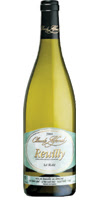Tasting current Languedoc-Roussillon VdPs: Domaine de Gourgazaud & Laroche 2005
A good way to define Vin de Pays wine is to compare it to wine of the French appellation (AOC) system. But when you only discovered the French appellation system the moment that Wine Blogging Wednesday 33 was announced last month, the comparison may not be all that instructive.
That's why I think the best way to define a Vin de Pays wine is to taste it!
For WBW 33, try to pick a moderately priced bottle ($15-30) and assess its value. Your bottle could be a Languedoc-Roussillon Vin de Pays (VdP) or, of course, a Languedoc-Roussillon AOC wine (more about AOC in the original WBW 33 announcement which is linked above). Any mid-priced wine is allowed to participate, just as long as it comes from this southern French region sometimes known as the Midi. Things like colour, style of wine and alcohol content do not matter so focus on the fact that your bottle is mid-priced and features the right designation of origin on the label.
Since vin de pays is a new topic for those following along with WBW 33 preparations, I've created a complete listing of VdP classifications that indicate a Languedoc-Roussillon product. By consulting this list you can find out if the vin de pays you dig up will be eligible for the blogging event on May 16. Why not try out any vin de pays you find until then? Here are a couple of bottles of vin de pays from Languedoc-Roussillon that I drank recently and what I thought of them.
Here are a couple of bottles of vin de pays from Languedoc-Roussillon that I drank recently and what I thought of them.
Like taking a bite out of the most ripe and delicious fruit. Laroche Viognier Vin de pays d'Oc 2005 (click on image at left for more details) has citrus and a hint of spice, making it edgy and refreshing rather than heavy, as the often full-bodied Viognier grape can be. This wine is testament to the tremendous fruit of this grape variety. An outstanding example of the well-balanced and aromatic attack of a lovely transplated northern Rhone grape and it's one that comes with a very small price. Laroche sets the price so low (about $14) that it's not technically eligible for WBW 33.
Béziers, France. 13.5%.
I'm not going to pretend I love every wine from Languedoc-Roussillon that I've ever tasted. For the sake of impartiality, here is a not-so-good wine from Languedoc-Roussillon, another Viognier varietal. Domaine de Gourgazaud Viognier Vin de pays d'Oc 2005 (click on image at right for more details) delivers fat flavours without much refreshment value, and features a prominent apple profile with some white peach. Lacks the dazzle, if not the acidity, of the above, which is a natural for a great aperatif wine. This one's a bit flat.
La Livinière, France. 13.5%.
These wines are both of the frequently-cheap Vin de Pays d'Oc classification. The Oc designation embodies an area as big as all of Languedoc-Roussillon itself. This enables winemakers to use grapes from a vast geographical area. Since this means that partnerships among various producers across the land can be made, it is not surprising that the bottles often would be inexpensive.
A NOTE ABOUT THE TYPE ON THE LABEL
I often look at the location listed on a bottle of wine. (Maybe this is why I am so maniacal for WBW 33!) Usually the place on the label is where the wine producer vinified, cellared or bottled his product. It's not necessarily where the grapes come from (that why the designation of the wine is needed).
This is interesting to me, and not just in the context of VdP wines. But in the case of VdP wines, when you see where the producers are based, you can try to guess what the other possible designations the producer could've labeled his wines. Had Michel Laroche been more choosy and used only grapes from his immediate zone around Béziers, could he have made a wine with a more specific designation like Vin de Pays du Coteau du Libon? Or in the case of the Domaine de Gourgazaud based in La Livinière, which is the heart of the Minervois appellation, why not go for an AOC Minervois classification? Neither case may be an option (and this interpretive guide from France is one of the few online resources that may help explain why in English). Basically, neither case is an option because even VdP rules vary from one VdP classification to another (Libon restrictions are separate from D'Oc restrictions), and because Minervois doesn't permit the production of Viognier varietals. So multiple designation options are not always available to winemaker for the wine he or she wants to make. Hence the plethora of vin de pays.
Hey, regulations can't always seem sexy -- uncork a vin de pays today and let it speak for itself. And then maybe thank the great Gassac's Aimé Guibert for inventing the stuff.

















